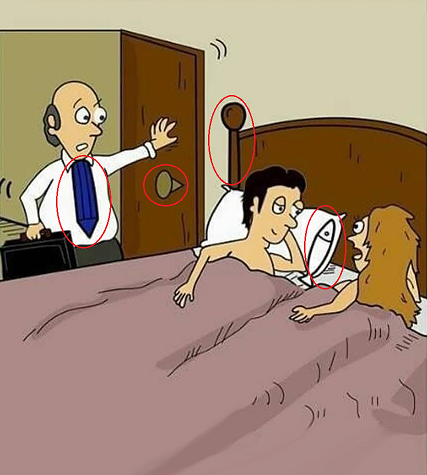Welcome, puzzle hunters!
If you enjoy hidden-object challenges, today’s riddle is for you. At first glance, the scene looks like a simple cartoon of a surprise visit to a bedroom. Look again, and you’ll realize four everyday objects are cleverly concealed: a fish, a pencil, a nail, and a box of matches. Can you spot them all without peeking at the solution? How long will it take you? And most importantly—what strategy will you use? Before we dive into a guided walkthrough, try giving yourself a full minute to explore the image. Set a timer, scan slowly from left to right, and mark the spots you think might hide something unusual. Ready to play? Let’s go.

Why these puzzles trick us (and how to avoid the traps)
Hidden-object illustrations are masterclasses in visual misdirection. Artists rely on three common principles to trip us up:
- Expectations vs. reality.
Our brains make predictions. We expect a fish to be near water, a pencil on a desk, a nail on a wall, and matches in a drawer. When the image places them in unexpected locations, our mental filter hides them in plain sight. The solution is to suspend assumptions and look for shapes, not objects—curves, lines, and edges that resemble the silhouette of the target regardless of context. - Camouflage by context.
Designers borrow textures and colors from their surroundings to mask the object. A wooden matchbox can blend into a headboard; a gray nail can vanish against a wardrobe hinge. To beat this trick, switch to a contrast-first scan: look for outlines that break the flow of a larger surface, or for repeated patterns that suddenly change. - Tunnel vision and rush decisions.
Many players move their eyes too quickly, focusing only on the “busy” center and ignoring borders and corners. The cure is a systematic sweep. Divide the picture into zones—left, center, right; foreground, midground, background—and clear each area before moving on. Slow is smooth, smooth is fast.
Your step-by-step roadmap to victory
We’ll now walk through a careful search method that mirrors how professional spot-the-difference solvers work. Even if you already found one or two items, follow the full process to see how a structured approach saves time and boosts accuracy.
Video : I’m Sure You Can’t Find The 4th Object
Step 1: Establish a grid and anchor points
Start by choosing four anchors: the door on the left, the man’s head near the pillows, the headboard posts, and the wardrobe or cabinet. Use these as reference beacons so your eyes don’t dart randomly. Imagine thin invisible lines dividing the image into three vertical columns (left—door; middle—bed; right—wardrobe and headboard post).
Step 2: Hunt for the fish—follow the curves
Fish shapes often hide where curved outlines already exist. In this scene, resist the urge to scan the floor or corners. Instead, focus on the pillow behind the man’s head. Notice how a simple black outline forms the unmistakable silhouette of a fish—eye, body, and tail—blended into the pillow’s edge. It’s not colored like a fish; it’s drawn by the pillow’s contour and a minimal stroke.
Answer 1: The fish is on the pillow where the man is lying.
Step 3: Track the pencil—think long and narrow
Pencils are linear and often hide inside other long, narrow shapes such as ties, straps, or bedposts. Shift your gaze left to the figure standing by the door. His necktie is the giveaway. What looks like a plain tie actually doubles as the shaded outline of a pencil: straight shaft, pointed tip, darker central “lead.” This is a classic example of semantic camouflage—a pencil disguised as clothing.
Answer 2: The pencil is hidden in the standing man’s tie.
Step 4: Nail the nail—inspect hardware and edges
Nails blend well with wooden textures and metal fittings. Look to the wardrobe/cabinet at the left or slightly behind the door area. There’s a small, circular hardware detail where the wood grain meets the edge. That protruding dot with a tiny highlight isn’t just a knob or random pixel—it’s the nail head, deliberately placed to match the furniture’s style. When an object is tiny, the artist hides it as part of an existing mechanical element.
Answer 3: The nail is on the wardrobe/cabinet.
Step 5: Strike the matches—search for rectangular interruptions
Matchboxes are rectangular with a distinct border, and they love to hide where similar rectangles live: books, panels, and rails. Shift your attention to the headboard’s horizontal rail. One segment interrupts the wood’s flow with a slightly different outline—suggesting a small box of matches fused into the headboard design. If you trace the edges, you can visualize the lid and the striking strip.
Answer 4: The matches are on the headboard bar.

Step 6: Verify with a reverse scan
A good solver always double-checks. Reset your eyes and run a reverse sweep—from right to left this time. Confirm you can relocate each object quickly without second-guessing: fish on pillow, pencil-tie, nail on wardrobe, matches in headboard bar. If you can do that in under ten seconds, you’ve internalized the visual cues and completed the challenge like a pro.
Why small details fool even careful observers
Let’s unpack what made each hiding place successful:
- Shape substitution. The pillow outline becomes the fish’s body. We’re trained to see “pillow,” not “fish,” so our mind auto-labels the shape and moves on.
- Functional overlap. A tie is the same geometry as a pencil. By aligning the shading to imply a graphite core and a sharpened point, the image convinces us it’s still just a tie.
- Scale deception. The nail is extremely small and occupies a reasonable spot for furniture hardware. Because our brain condenses tiny details into “noise,” we rarely question them.
- Texture continuity. The matchbox shares the headboard’s wood tone. Only the outline betrays it. When texture matches perfectly, we must pay attention to edges, not colors.
Pro tips for your next hidden-object challenge
- Zoom with intention. If you’re viewing on a phone, pinch to zoom on flat surfaces and borders; artists frequently hide objects along clean lines where your eyes glide past.
- Name the silhouette. Say out loud the shape you are looking for—“a fish profile,” “a hexagonal pencil tip”—to prime your brain to match contours, not contexts.
- Alternate brightness. If possible, dim your screen slightly; lower contrast reduces texture distractions and lets outlines pop.
- Use the clock, not pressure. Give yourself two timed passes: a fast 20-second scan for obvious mismatches, then a slow 60-second pass for edges and corners.
Video : 👀 Spot The 4th Object –
A quick recap of the official solution
To keep everything crystal clear, here are the confirmed locations:
- Fish — cleverly drawn on the pillow behind the man’s head.
- Pencil — disguised as the tie of the person standing by the door.
- Nail — placed on the wardrobe/cabinet hardware.
- Matches — hidden along the headboard’s horizontal bar.
Now it’s your turn—join the conversation
Did you spot all four before reading the walkthrough? Which one took you the longest? Share your time, your strategy, and the order you found them in the comments. If you discovered any other details that felt like red herrings—maybe a knob that looked like a coin or a shadow that resembled a key—tell us! Your insights help other players sharpen their attention and learn new techniques.
If you enjoyed this challenge, pass it along to a friend and see who claims the fastest time. Hidden-object puzzles are more fun when you compare tactics—some people hunt by color, others by shape, and some by pure gut feeling. There’s no single “right” method, but the step-by-step approach above will give you a reliable system for almost any scene.
Final words of encouragement
Keep training your observation muscles. The more puzzles you attempt, the faster your brain becomes at toggling between “context” and “contour,” the core skill that separates casual guessers from expert solvers. Try a few more riddles this week, challenge yourself to beat your best times, and remember: every image hides a story. All you need is patience, a steady scan, and a curiosity that refuses to blink. Happy hunting!
